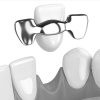Split and Cracked Teeth
Although the enamel is one of the strongest substances in the human body, cracked teeth are one of the most common emergency dental situations your Springfield dentist encounters. Whether the damage is from cavities or a traumatic blow to the face, cracked teeth can be repaired to restore your smile.
Types of Cracked Teeth 
Here are the most common classifications:
Craze Lines: These tiny cracks are on the surface of the tooth, are quite common in adults and cause no problems, unless it is a cosmetic concern.
Fractured Cusp: This is when a piece on the tooth surface breaks away and is normally not painful.
Cracked: This is when the crack extends from the surface of the tooth to the root. It is imperative for early dental treatment or else the tooth may too far gone to save.
Split Tooth: This normally comes from a long-term cracked tooth and has parts that can be separated from the crack. The tooth cannot be saved.
Vertical Root Fracture: These cracks are in the root of the tooth and extend towards the chewing surface. They often show no symptoms and are only discovered when the bone and gum around the tooth become infected.
How Can a Cracked Tooth Be Repaired?
Here are the methods used to fix this dental emergency:
Dental Bonding: A composite is placed on the top of the tooth surface and then polished and shaped to match the rest of your teeth.
Veneers: Porcelain veneers are an excellent cosmetic solution for many people. The veneer is attached to the front of the tooth and it can last for up to 30 years.
Crowns: This is the most common method of repair where a cap is simply placed over the tooth to protect it.
Root Canal: If there is damage to the root of the tooth, it will need to be cleaned and removed.
Dental Implant: If the crack in the tooth extends below the gumline, it cannot be saved. An implant takes the place of the missing tooth and is a new root is created by implanting a screw in the jaw.



